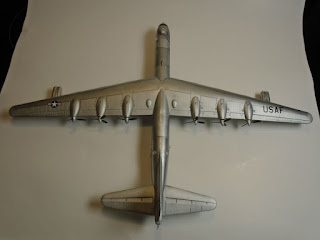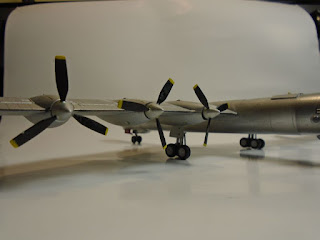 |
| The R in RB-36 makes this the reconnaissance version of the B-36. It was very good at the role, as it could fly high and carry gigantic cameras |
 |
| Ten engines, six piston and four jet. Yes it was a bit complex |
 |
| For comedy reasons named the "Peacemaker" by its manufacturer, the B-36 was the only airplane that could carry America's first hydrogen bombs without modification. |
The other place where my technique kinda fell down was the transparencies. Several methods were tried, and in the end freehand painting provided the best results. And of course all those attempts fogged the canopy. This isn't that a big deal; interior details are minimal at this scale and all but invisible even with that canopy done properly - but I'm conscious that my transparent game is behind some of my other skills.
The rest of the kit is quite good in my opinion, though there are one or two places where kit engineering isn't state of the art. For one, the wings droop slightly, which is contrary to what they were in real life. I managed to mostly cure the droop with wooden dowels glued into the wings. The other thing is that the engine intakes are "solid"; IE they are just rendered in plastic with no actual intake holes. I carved out the holes, though I think if you look really close you can see it is a little rough around the edges. This is because I tried to preserve the "crossbars" on the intake and carved around them. Next time, I'm just going to remove the whole thing and replace the crossbars with that stock styrene all you fancy modellers use.
I also used auto-body filler for putty, which is something I'm sticking with. It actually created strong sand-able bonds. A slight accident when I used it to secure weight in the nose:. I just used lots of it to secure the weights and ball bearings, and it melted the lower radar dome a bit, which required some more filler and some sanding. (So lesson learned: use lots and the fumes might melt plastic.)
The decals went on quite nicely, and I forget if I did my usual topcoat of future ontop of them. At any rate, marking (even the wing-walks) were no problem.
As is my method I'm going to do some sort of modest infodump on the B-36 family, though it will be a bit less obsessive than some posts, simply because this is a pretty famous warbird by most standards, and the work is not so much one of researching to solve mysteries as it is just putting together good sources. I also think I'm sticking to well engineered kits for awhile: While Hobbycraft was better than Amodel, both required much endurance to make them look right to me, which is kinda draining.
 |
| For scale, three more contemporary fighters. Even the large F-14 looks tiny beside the RB-36. |







